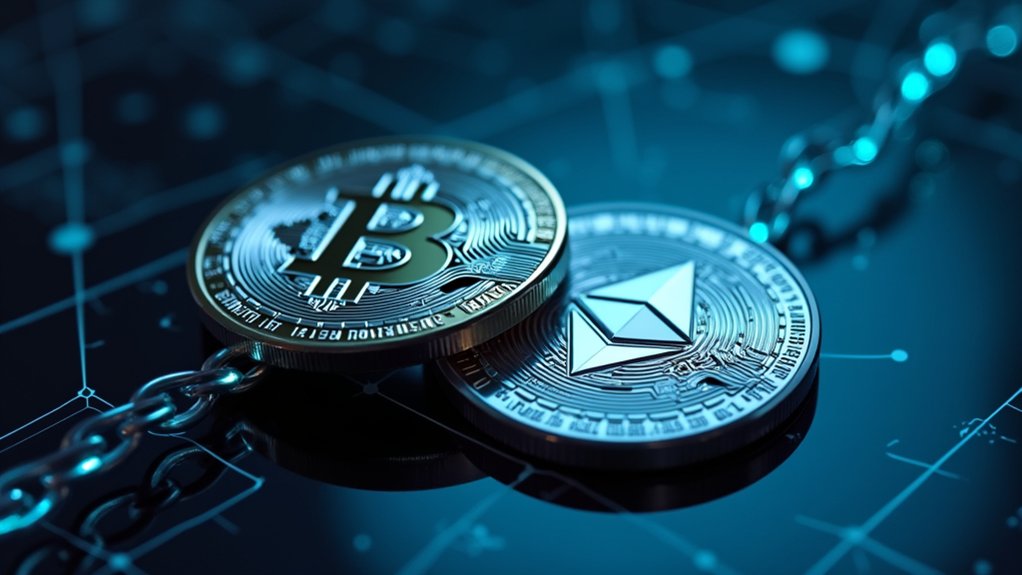Atomic swaps, a revolutionary yet ignored tool, enable direct cross-blockchain trades without greedy intermediaries, slashing costs and reclaiming user control. Why cling to outdated, fee-heavy systems that mock your autonomy? They operate via smart contracts, enforcing all-or-nothing trades with brutal precision, though flawed code or user idiocy can spell disaster. Don’t assume they’re flawless; vulnerabilities lurk, demanding vigilance. Stick around to uncover the raw potential and pitfalls of this disruptive tech.

How can the cryptocurrency world still cling to clunky, intermediary-laden exchanges when a sharper, more direct solution like atomic swaps exists? Honestly, it’s baffling—a bloated system persists while a lean, peer-to-peer mechanism gathers dust, ignored by the masses too comfortable with outdated middlemen. Atomic swaps, at their core, are a game-changer in Swap Basics, enabling direct trades across distinct blockchains without some greedy third party skimming fees or bungling transactions. Why settle for less when you can cut the fat? Plus, they reduce counterparty risks by ensuring users maintain control over their assets during the trade.
Let’s not pretend, though, that this innovation is flawless or risk-free. Security Risks loom large, and anyone diving in blind deserves the headache they’ll get. These swaps rely on smart contracts—brilliant, yes, but only as secure as the code behind them, which, let’s face it, isn’t always bulletproof. A single glitch, a poorly timed exploit, and poof, your assets vanish faster than trust in a shady exchange. The atomicity principle, ensuring trades happen fully or not at all, is a safeguard, but it doesn’t shield against human error or malicious hacks. Are we really paying attention to these gaps, or just hoping for the best? Since their inception in 2017, atomic swaps have demonstrated the potential to revolutionize trading by eliminating intermediaries eliminating intermediaries. Moreover, their ability to enable trades mirrors the functionality of cross-chain bridges, fostering blockchain interoperability across disparate networks for seamless asset transfers.
The process, powered by Hashed Timelock Contracts, demands precision—both parties lock funds, meet conditions, or the deal auto-cancels. It’s elegant, ruthless even, slashing counterparty risk, yet the tech’s complexity alienates most. Why isn’t the crypto community pushing harder for accessibility? Costs drop, decentralization thrives, but adoption lags—pathetic. Atomic swaps aren’t just a tool; they’re a wake-up call to ditch the old guard. So, what’s the holdup? Is it ignorance, laziness, or fear of a system that actually works? Step up, learn the ropes, and stop cowering behind obsolete platforms. The future isn’t waiting.
Frequently Asked Questions
What Are the Risks of Atomic Swaps?
Atomic swaps pose significant risks to users. Fraud Concerns arise from potential transaction interruptions, while Privacy Issues emerge due to traceable public addresses. Additionally, security vulnerabilities and complex setups heighten the overall risk.
Which Cryptocurrencies Support Atomic Swaps?
Several cryptocurrencies support atomic swaps, including Bitcoin, Monero, Solana, and Cardano. Future Integrations are expected to expand compatibility, while Emerging Coins may soon join, enhancing cross-chain trading options in the evolving blockchain landscape.
How Long Do Atomic Swaps Take?
Regarding Swap Timing, the time an atomic swap takes varies. Duration Factors include network congestion, block mining times, and time-lock settings. These elements collectively determine how quickly transactions are completed across blockchain networks.
Are Atomic Swaps Completely Decentralized?
Atomic swaps are largely decentralized, embodying a Decentralized Architecture that eliminates intermediaries. They facilitate Trustless Exchanges via smart contracts, though challenges like blockchain compatibility and liquidity issues can hinder complete decentralization in practice.
Can Atomic Swaps Be Reversed?
The question of whether atomic swaps can be reversed is significant. They lack Reverse Protocols, and Undo Scenarios are not supported, as swaps are designed to be irreversible once executed, ensuring transaction finality.









